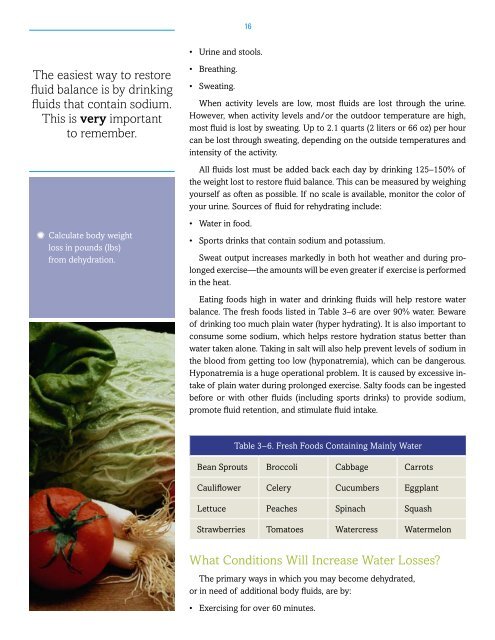special-operations-nutrition-guide
special-operations-nutrition-guide
special-operations-nutrition-guide
Create successful ePaper yourself
Turn your PDF publications into a flip-book with our unique Google optimized e-Paper software.
16<br />
• Urine and stools.<br />
The easiest way to restore<br />
fluid balance is by drinking<br />
fluids that contain sodium.<br />
This is very important<br />
to remember.<br />
• Breathing.<br />
• Sweating.<br />
When activity levels are low, most fluids are lost through the urine.<br />
However, when activity levels and/or the outdoor temperature are high,<br />
most fluid is lost by sweating. Up to 2.1 quarts (2 liters or 66 oz) per hour<br />
can be lost through sweating, depending on the outside temperatures and<br />
intensity of the activity.<br />
All fluids lost must be added back each day by drinking 125–150% of<br />
the weight lost to restore fluid balance. This can be measured by weighing<br />
yourself as often as possible. If no scale is available, monitor the color of<br />
your urine. Sources of fluid for rehydrating include:<br />
==Calculate body weight<br />
loss in pounds (lbs)<br />
from dehydration.<br />
• Water in food.<br />
• Sports drinks that contain sodium and potassium.<br />
Sweat output increases markedly in both hot weather and during prolonged<br />
exercise—the amounts will be even greater if exercise is performed<br />
in the heat.<br />
Eating foods high in water and drinking fluids will help restore water<br />
balance. The fresh foods listed in Table 3–6 are over 90% water. Beware<br />
of drinking too much plain water (hyper hydrating). It is also important to<br />
consume some sodium, which helps restore hydration status better than<br />
water taken alone. Taking in salt will also help prevent levels of sodium in<br />
the blood from getting too low (hyponatremia), which can be dangerous.<br />
Hyponatremia is a huge operational problem. It is caused by excessive intake<br />
of plain water during prolonged exercise. Salty foods can be ingested<br />
before or with other fluids (including sports drinks) to provide sodium,<br />
promote fluid retention, and stimulate fluid intake.<br />
Table 3–6. Fresh Foods Containing Mainly Water<br />
Bean Sprouts Broccoli Cabbage Carrots<br />
Cauliflower Celery Cucumbers Eggplant<br />
Lettuce Peaches Spinach Squash<br />
Strawberries Tomatoes Watercress Watermelon<br />
What Conditions Will Increase Water Losses?<br />
The primary ways in which you may become dehydrated,<br />
or in need of additional body fluids, are by:<br />
• Exercising for over 60 minutes.


